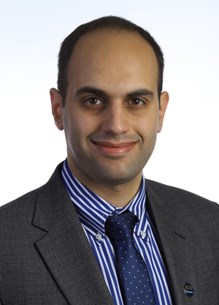Meeting
2019 ASCO Annual Meeting

Indiana University School of Medicine, Indianapolis, IN
Mohammad Issam Abu Zaid , Michael T. Milano , Paul C Dinh Jr., Sophie Fosså , Hongmei Yang , Darren R. Feldman , Lois B. Travis , Chunkit Fung
Background: No large, population-based U.S. study has comprehensively examined SMN and HMN risks after TC, taking into account initial therapy and focusing on recent decades. Methods: Standardized incidence ratios (SIR) for SMN and HMN stratified by site and time since TC diagnosis were calculated for 24,900 TCS (median age, TC diagnosis: 33 y) reported to population-based cancer registries in the NCI SEER program (1973-2014). TCS were initially given CHEM (n=6,340), RT (n=9,058), or SURG (n=8,995), with each group accruing 80,700, 156,735, and 128,039 person-years (PY) of follow-up, respectively. Results: During 372,709 PY of follow-up, 1,625 TCS developed SMN and 228 developed HMN, including 107 lymphomas, 92 leukemias, and 29 plasma cell dyscrasias. Among all TCS, overall risk of SMN was increased by 1.06-fold (95% CI 1.01-1.1). Risks of SMN were increased after RT (SIR 1.1, 95% CI 1.06-1.2) and CHEM (SIR 1.3, 95% CI 1.1-1.4); but not after SURG (SIR 0.8). After CHEM, significant excesses of SMN of the pancreas (SIR 2.2), soft tissue (SIR 4.0), kidney (SIR 1.7), thyroid (SIR 3.3) occurred; after RT, significantly elevated risks for SMN of the stomach (SIR 1.7), rectum/sigmoid (SIR 1.4), pancreas (SIR 2.7), soft tissue (SIR 2.2), bladder (SIR 1.5), and thyroid (SIR 2.0) were observed. The 30 year cumulative incidence of SMN after SURG, CHEM, and RT was 8.9% (95% CI 7.8-9.9), 10.1% (95% CI 8.8-11.5) and 17.0% (95% CI 15.8-18.2), respectively. Significantly increased risks of leukemia followed CHEM (SIR 2.7) and SURG (SIR 1.8) and were driven by increased risks for acute myeloid leukemia, with significant excesses restricted to 1-10 y and 1-5 y after TC diagnosis, respectively; nonsignificant 2-fold excesses occurred 1-10 y after RT. Risks for lymphoma and plasma cell dyscrasias were not elevated (1.02 and 1.27, respectively). Conclusions: In the largest population-based study of U.S. TCS to date, we report significant 6% excesses of SMN and 2-fold increased risks of leukemias. Efforts to minimize CHEM exposure and decrease doses/field size of RT in TC should continue. TCS should be educated about cancer prevention and screening.
Disclaimer
This material on this page is ©2024 American Society of Clinical Oncology, all rights reserved. Licensing available upon request. For more information, please contact licensing@asco.org
2019 ASCO Annual Meeting
Poster Session
Symptoms and Survivorship
Symptom Science and Palliative Care
Late and Long-Term Adverse Effects
J Clin Oncol 37, 2019 (suppl; abstr 11573)
10.1200/JCO.2019.37.15_suppl.11573
11573
265
Abstract Disclosures
2023 ASCO Annual Meeting
First Author: Carla Bellido Ribes
2022 ASCO Annual Meeting
First Author: Sjoukje Lubberts
2021 Genitourinary Cancers Symposium
First Author: Davide Bimbatti
2023 ASCO Genitourinary Cancers Symposium
First Author: Tyler J. Nelson